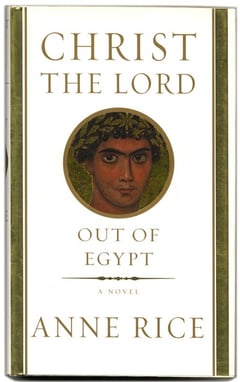With 100 million books sold, Anne Rice enjoys the sort of success available to only a few authors per generation. Rice made a name for herself with her influential spin on the gothic genre, to which she adds another title, Prince Lestat and the Realms of Atlantis, this year. You may know her from her famous Vampire Chronicles series, though her forty-volume career encompasses far more. Below, we’ve compiled five highlights from Anne Rice’s prolific career.
Interview with the Vampire

Published in 1976, Interview with the Vampire became a smash success, and transformed the way popular culture conceived of the famous gothic monster. No longer a predatory villain in the style of John Polidori or Bram Stoker, Rice’s Louis de Pointe du Lac is a charismatic vampire who charms the reader as much as he taunts her with his moral ambiguity. The novel, which has sold over eight million copies, is rightly credited with rejuvenating the vampire’s image as an erotic character for popular enjoyment, to which the likes of Twilight and True Blood owe a considerable debt.
Pandora
A novel of the Vampire Chronicles series, Pandora begins in the days of the Roman Republic. The title character, being an immortal vampire, suffers through the centuries, from late 1600s Germany to 1980s America. In this novel, Rice extends the purview of vampires to include those made depressed by their long lives, as well as participants in a grand, often evil population of vampires.
Violin
In this ghost story, Anne Rice shifts her narrative around a roster of exciting periods and places, including New Orleans, Rio de Janeiro, and nineteenth century Vienna. The book centers on two characters, Triana, a recent widow, and Stefan, a ghost who guides her through different times. Triana soon finds herself in 1800s Vienna, embodied as a superb violinist and contemporary of Beethoven. Triana eventually recovers her past, and allows Stefan to pass to the other realm, no longer haunting the living.
The Witching Hour
In this 1990 novel, Rice inaugurates her second gothic series, The Lives of the Mayfair Witches. It opens with Rowan Mayfair, a successful Californian doctor who discovers her psychic powers, with the capacity both to harm and to heal. At the heart of the book, however, is the villain Lasher, a charming though demonic spirit who has tormented the Mayfair line for centuries, starting with an ancestor in the seventeenth century who was burned at the stake for witchcraft. It’s just the read for someone who loves romping, modern reinterpretations on one of the oldest and most beloved magical creatures.
Christ the Lord: Out of Egypt
 Anne Rice has been very public about her religious journey. In her earlier years, she was an atheist, a position strengthened by the death of her infant daughter while she was writing her first book. She returned to the Catholicism of her youth, which inspired her to write Christ the Lord, released in 2005. She has since renounced her formal belonging to the Church; a 2010 Facebook post outlined her grievances with the institution’s misdeeds and its Scripture-based intolerance. Though she has departed from the Catholic religion, she is still religious, and believes in the holiness of Jesus and God.
Anne Rice has been very public about her religious journey. In her earlier years, she was an atheist, a position strengthened by the death of her infant daughter while she was writing her first book. She returned to the Catholicism of her youth, which inspired her to write Christ the Lord, released in 2005. She has since renounced her formal belonging to the Church; a 2010 Facebook post outlined her grievances with the institution’s misdeeds and its Scripture-based intolerance. Though she has departed from the Catholic religion, she is still religious, and believes in the holiness of Jesus and God.
The book itself is distinct in her canon. It does not pursue the same thrills that readers of her spookier, gothic books would expect. Instead, it is a reverent interpretation of a year in the life of Jesus Christ. It remains one of Rice’s better-reviewed books. Author Lev Grossman praised it, and The New York Times noted that “the restraint and prayerful beauty of Christ the Lord is apt to surprise Rice's normal readers and attract new ones.” After reading this novel, you might count yourself as either of the two.









